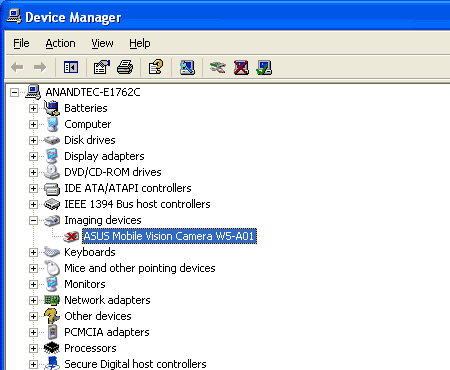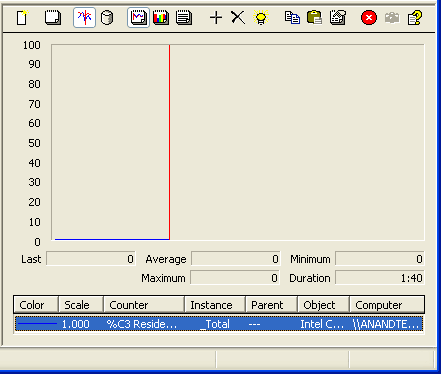Intel Core Duo USB Issue: A Mischaracterized Bug
by Anand Lal Shimpi on February 13, 2006 1:40 PM EST- Posted in
- Laptops
Problem #2 - Disabling a USB device doesn't work
If we now know that this problem should affect both Napa (Core Duo) and Sonoma (Pentium M) platforms, why is it that the results that we've seen to date don't support that theory? While we can only comment on tests that we've run ourselves, we did run into some issues with the ASUS W5F/W5A notebooks, which are quickly becoming popular Napa/Sonoma test platforms.
The reason that the two ASUS notebooks are nice to use is because they are virtually identical systems, one simply uses a Sonoma motherboard with a Pentium M CPU while the other uses a Napa board with a Core Duo CPU. In the end, it provides an excellent level playing field for comparing Core Duo to its predecessor.
With a USB 2.0 device (an external TV tuner) connected, but no driver installed, the battery life on our T60 dropped from 286 minutes down to 242, a reduction of 15.3%. Disabling the device had no effect either, as we recorded a battery life of 235 minutes. These findings are particularly important because both ASUS notebooks, the Sonoma and the Napa, feature an integrated USB 2.0 camera. Even without the drivers loaded, short of ripping the camera out of the system, these two notebooks are terrible reference points for the USB power draw issue as both of them exhibit the issue without even plugging in any external devices!
To confirm, we looked at C3 time once more on both platforms:
To further confirm, we applied the workaround documented in the Microsoft KB article. With no external devices connected to either system, their battery life jumped by approximately another hour:
While this means that our battery life tests from our Core Duo notebook article are significantly lower than they should be (we'll be providing a follow-up to that article in the near future), it also means that neither ASUS notebook should be used in pinpointing the cause or effects of this USB problem.
Adding an external USB 2.0 device to either ASUS notebook does result in an additional drop in battery life, but the initial damage is done by the integrated camera that you can't unplug. To truly isolate this problem, we'll need two notebooks that don't have any integrated USB 2.0 devices, which is why we turned to the Lenovo Thinkpad T43 and T60.
If we now know that this problem should affect both Napa (Core Duo) and Sonoma (Pentium M) platforms, why is it that the results that we've seen to date don't support that theory? While we can only comment on tests that we've run ourselves, we did run into some issues with the ASUS W5F/W5A notebooks, which are quickly becoming popular Napa/Sonoma test platforms.
The reason that the two ASUS notebooks are nice to use is because they are virtually identical systems, one simply uses a Sonoma motherboard with a Pentium M CPU while the other uses a Napa board with a Core Duo CPU. In the end, it provides an excellent level playing field for comparing Core Duo to its predecessor.

| Lenovo T60 | Nothing Connected | USB 2.0 Device Connected, No Driver Installed | USB Device Disabled |
| Reader 2002SE Battery Life in Minutes | 286 | 242 | 235 |
With a USB 2.0 device (an external TV tuner) connected, but no driver installed, the battery life on our T60 dropped from 286 minutes down to 242, a reduction of 15.3%. Disabling the device had no effect either, as we recorded a battery life of 235 minutes. These findings are particularly important because both ASUS notebooks, the Sonoma and the Napa, feature an integrated USB 2.0 camera. Even without the drivers loaded, short of ripping the camera out of the system, these two notebooks are terrible reference points for the USB power draw issue as both of them exhibit the issue without even plugging in any external devices!
To confirm, we looked at C3 time once more on both platforms:

The ASUS notebooks never enter C3 or lower power states, even with no external devices connected
To further confirm, we applied the workaround documented in the Microsoft KB article. With no external devices connected to either system, their battery life jumped by approximately another hour:
| Reader 2002SE Battery Life in Minutes | Nothing Connected | Nothing Connected (MS Fix Applied) |
| ASUS W5F (Napa/Core Duo) | 219 | 264 |
| ASUS W5A (Sonoma/Pentium M) | 204 | 273 |
While this means that our battery life tests from our Core Duo notebook article are significantly lower than they should be (we'll be providing a follow-up to that article in the near future), it also means that neither ASUS notebook should be used in pinpointing the cause or effects of this USB problem.
Adding an external USB 2.0 device to either ASUS notebook does result in an additional drop in battery life, but the initial damage is done by the integrated camera that you can't unplug. To truly isolate this problem, we'll need two notebooks that don't have any integrated USB 2.0 devices, which is why we turned to the Lenovo Thinkpad T43 and T60.










61 Comments
View All Comments
Mezcal - Tuesday, February 14, 2006 - link
Hello, I tested perfmon after reading your test. I own an Acer Aspire 5024 with a Turion 64 ML34 inside. So, I was wondering if this could cause me any battery problem. After testing Perfmon with % C3 time with USB wireless mini mouse, I can see a graph with mountains (between 60 and 100%) while the USB mouse is not plugged in and completely flat (0%) while plugged in. So, this may be the result of the problem you described? No?I didn't test the battery life with the USB mouse plugged in and without it 'cause I can't find any utility to test that. So, I can't say if it affects the battery life.
IntelUser2000 - Tuesday, February 14, 2006 - link
According to AT, it means Turion systems also have the same problem as the Centrinos in terms of battery life reduction when USB 2.0 devices are connected. Since % mean HOW OFTEN THE CPU IS IN LOW POWER C-STATE, 0% means its not going into low power states AT ALL, while 60-100% means its going into low power state 60-100% of the time.
NullSubroutine - Monday, February 13, 2006 - link
I am awaiting my new Dell Inspiron E1705 (2ghz Duo, 2GB 667mhz, 80GB SATA 7200, Ultrasharp 1920x1200, 7800GTX Go) I hope this issue has a better fix because it seemed the fix didnt work will with this system. I think the USB hub that is built into the system may be the cause of this, hopefully Anand can get the review of this system and see if he can fix. Personal request if anyone reads this, apply new artic silver on the cpu/gpu then see how much cooler it runs, and how much more you can overclock the gpu...pretty please...IntelUser2000 - Tuesday, February 14, 2006 - link
quasarsky - Tuesday, February 14, 2006 - link
weird. u say c4 is the 'sixth' power state. 0,1,2,3,4. sounds like it would be fifth. ???? am i missing something here?IntelUser2000 - Tuesday, February 14, 2006 - link
Anand said this:
For Pentium M
C0
C1
C2
C3
C4
Core Duo adds: deep C4
Coldfusion - Monday, February 13, 2006 - link
Or is it strictly a Windows issue?bobsmith1492 - Monday, February 13, 2006 - link
Wow.. so maybe this explains why my battery life is so different now than when my computer was new - I swear, when I first looked at it, it was saying 7 hours and I got like 5 when doing normal activities. With my mouse, though, it's more like 3-4... of course, it's a year older also. (P-M 1.7 Dothan)How can you tell whether or not a device is USB 2.0? I'm sure something in the device manager says, but I can't tell..
huges84 - Monday, February 13, 2006 - link
Why is it that the two Asus systems that are the same, except for motherboard and a slight difference in memory speed, showed that the Sonoma platform had better battery life than the Napa platform? I know it isn't much difference, but shouldn't the Napa be noticably ahead of Sonoma?Does the memory difference make that much of an impact? Or are the power consumption improvements in Napa pretty much only for when the processor is basically completely idle? If so then I don't think many people will see the extended battery life. Unless you like to leave your computer idle when it is running on battery. Maybe the improvements are also on the upper end and it is just the middle ground that didn't get improved. How high is CPU utilization in this test?
IntelUser2000 - Tuesday, February 14, 2006 - link
Well the difference is within margin of error. While W5F based on Core Duo gains less than W5A based on Pentium M, the difference is very little, less than 15 min.
Lenovo shows better results. T60 based on Core Duo always gets slightly better than T43 based on Pentium M, whether before or after, and T60 can support higher resolution, otherwise identical components.